THE AIRPORTS
SOUTHERN CALIFORNIA
LOS ANGELES
LAX
1980s
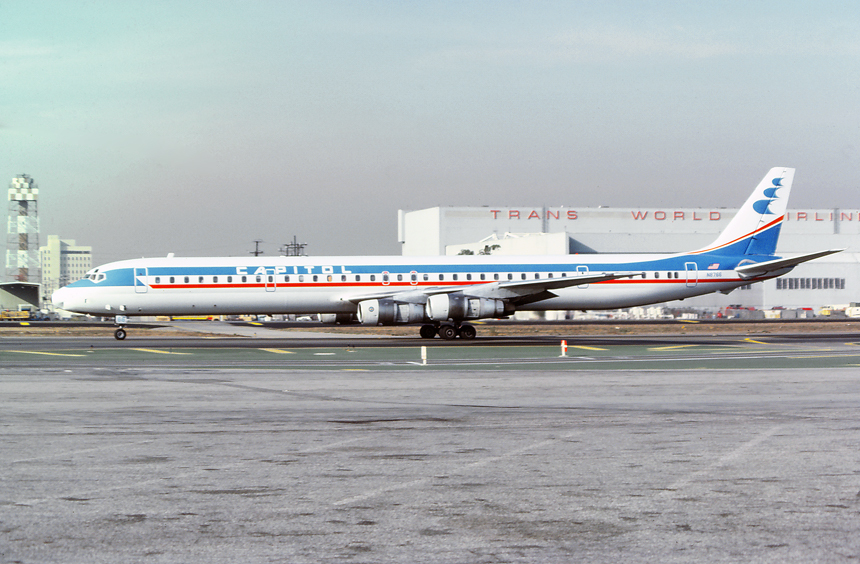
| January
1980 Founded in 1946 as Capitol Airways, a charter air carrier, the airline was eventually named Capitol International Air in 1967. Having secured many military charter contracts the airline introduced "jet" Douglas DC-8 flights in 1963, being one of the first charter airlines to do so. After deregulation in 1978, Capitol entered the scheduled market from a New York-JFK base of operations. Non-stop flights between Los Angeles and New York-JFK were promoted with low fares and in direct competition with major carriers American Airlines and Trans World Airlines (TWA) flying the same route. Seen taxiing along Taxiway 48 outbound toward Runway 25 Right is N8766, a Douglas DC-8-61, purchased by Capitol Air in June 1976. |

| January
1980 Golden West Airlines placed an order for two of the Shorts Brothers SH-330 turboprop in 1977 which almost doubled the de Havilland DHC-6 Twin Otter capacity. As Golden West continued to grow, the SH-330, with seating for thirty passengers allowed an increase in capacity on trunk routes such as Los Angeles-Ontario, and Los Angeles to Santa Ana/Orange County. The new Belfast, Ireland manufactured airframe also would require a flight attendant, a first for the airline. Parked on the commuter ramp during an early afternoon turn-around is N330GW, a Shorts SD-330-100 wearing the "earth-tone" colors which was introduced with the delivery of the first aircraft. |

| February
1980 The flag carrier of the Netherlands, KLM Royal Dutch Airlines is considered the oldest continually flying airline in the world, having started passenger services in 1919. Over the next fifty years, the airline grew into a global carrier introducing Douglas DC-8 "Jet" service in 1960 and expanding to serve seventy-five cities on six continents. On April 29, 1979, KLM inaugurated "Flying Dutchman" service to Los Angeles International Airport with non-stop flights to Amsterdam using a Douglas DC-10. Within a year, Boeing 747 aircraft were occasionally substituted on the four times weekly trans-Atlantic service as loads required. Seen rolling out on Runway 24 Right on a bright winter afternoon is PH-BUO "Missouri," a Boeing 747-206B, delivered new to the airline in September 1979. |
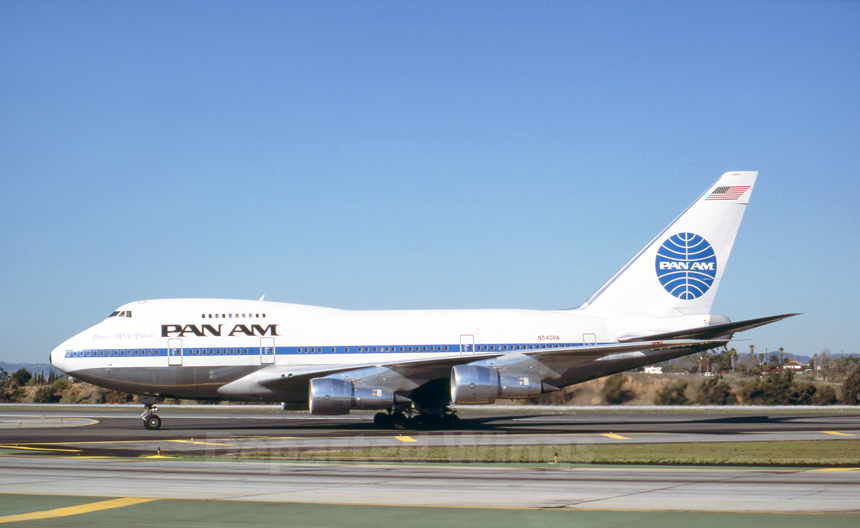
| March
1980 Pan Am, as the first customer of the "Special Performance" version of the Boeing 747, placed the plane on the ultra long-haul routes effectively connecting and conquering world-wide routes with a single flight. With a range of over 7,500 miles, the 747SP was a true intercontinental performer. Although initially envisioned for the lucrative New York-Tokyo route, the plane was placed on the Los Angeles-Sydney, Australia non-stop service in 1977, becoming the first airline to start non-stop service between the two continents and capturing the title of world's longest flight. Seen exiting off Runway 24 Right after a morning arrival is N540PA "Clipper White Falcon," a Boeing 747SP-21, delivered new to Pan Am on May 11, 1979. |
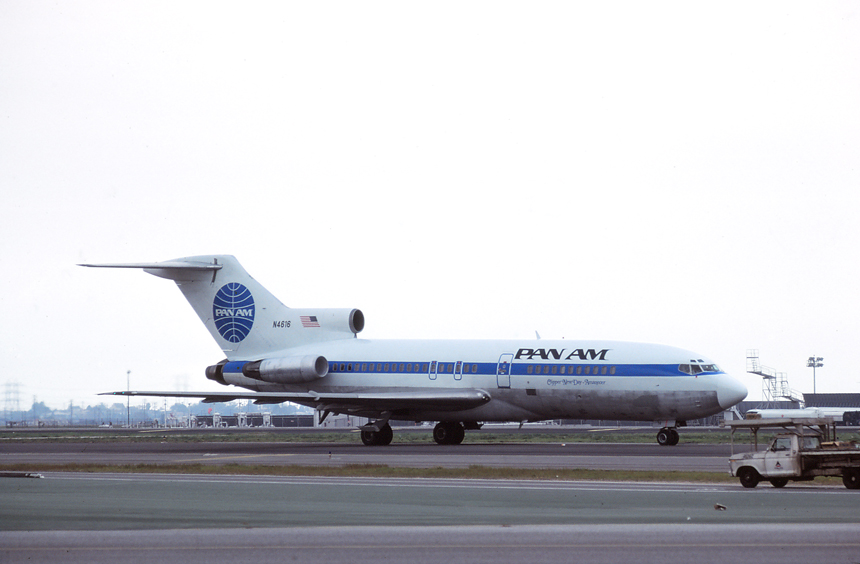
| March
1980 After the purchase of National Airlines in January 1980, Pan Am quickly began to repaint the existing National fleet into the familiar Pan Am colors. With the acquisition of National Airlines, Pan Am was able to provide a domestic route network from Los Angeles including five new cities to feed into its existing international routes from LAX. Taxiing to the Pan Am gates at Satellite Terminal 2 is N4616 "Clipper New Day-Amanecer," a Boeing 727-35, originally delivered to National Airlines in February 1965. |
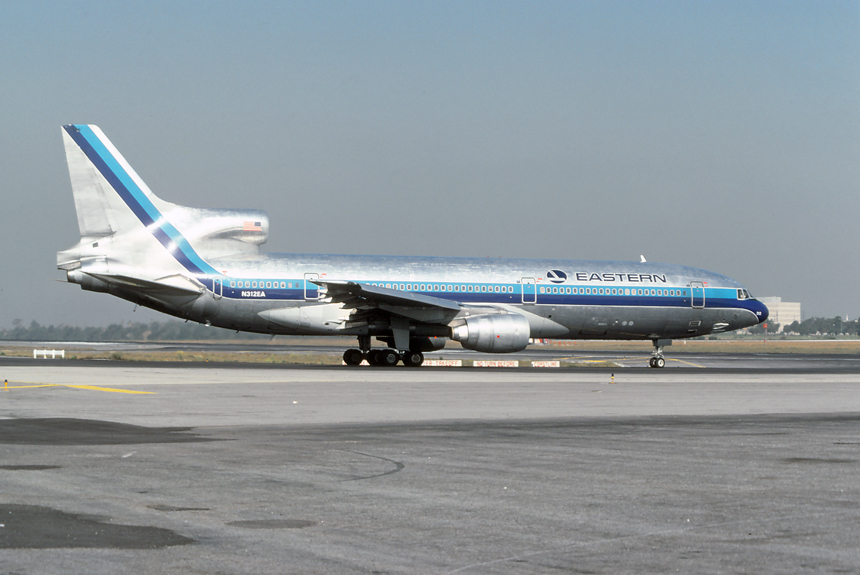
| April 1980
Eastern Airlines, like many of the mainline carriers during the early 1970s, purchased the Boeing 747 for high-capacity, transcontinental service. It was quickly realized that the 747 was too big and within a few years Eastern disposed of their few Jumbo’s. Looking to fill the void, of an airliner with medium-range yet decent passenger loads, Eastern selected the “space-age” Lockheed L-1011 tri-jet wide-bodied transport. With a substantial order of fifty Tristars in April 1971, Eastern become the launch customer for the new airplane. There was some initial worry that deliveries could not be made due to the Rolls Royce bankruptcy (and the only engine certified on the L-1011) however this was initially resolved. Eastern received its first L-1011 in March 1972 and dubbed “Whisperliners” started service between Miami-New York via Atlanta on April 26, 1972. Within a few years, the L-1011 started transcontinental service from Atlanta to Los Angeles and would become the flagship, high-capacity aircraft for Eastern until its demise in January 1991. Holding short of Runway 24 Left for a morning departure to Atlanta is N312EA, a Lockheed L-1011-1 Tristar. |
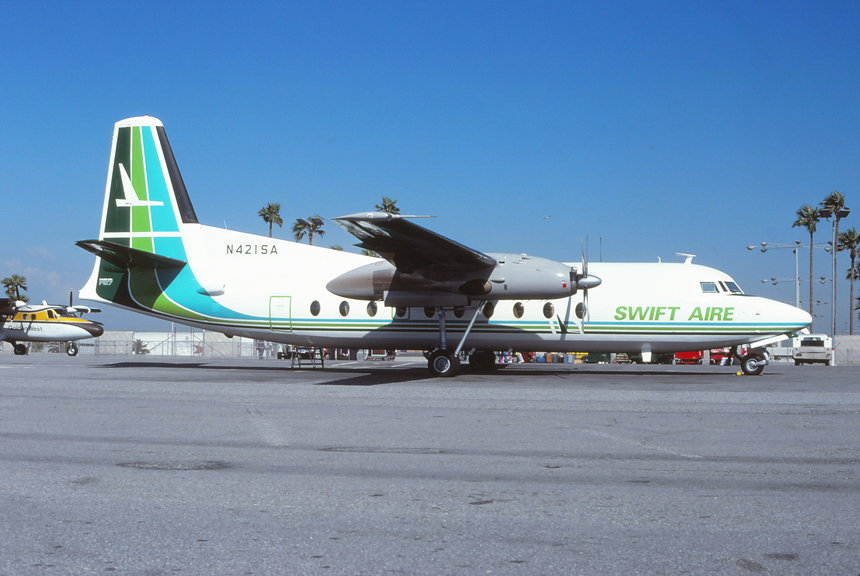
| April
1980 San Luis Obispo based Swift Aire took a checked sequence of growth from its humble beginnings in 1969. By 1979, the airline was starting to compete on routes with both established commuter carriers and regional airlines and required a larger capacity aircraft to remain popular. A decision was made to purchase three of the 50-seat turbo-props with the first two delivered in January 1980. The planes were used to replace the de Havilland Herons and placed on the higher capacity routes from San Luis Obispo to Los Angeles and San Francisco. Parked at the commuter ramp during an afternoon turnaround is N421SA, a Fokker F-27-600 "Friendship," and the first plane delivered to Swift Aire. |

| April 1980 By 1980, Western Airlines was operating forty of the Boeing 727 tri-jet with the plane making up the bulk of the short and medium ranged fleet. From Los Angeles, Western was using the 727 on flights as short as the 100-mile hop south to San Diego, to the 1600-mile international route to Acapulco, Mexico as well as to eight other cities served from the airport. Taxiing toward Runway 25 Right for an evening departure is N290WA, a Boeing 727-247, delivered new to the airline on June 19, 1979. |
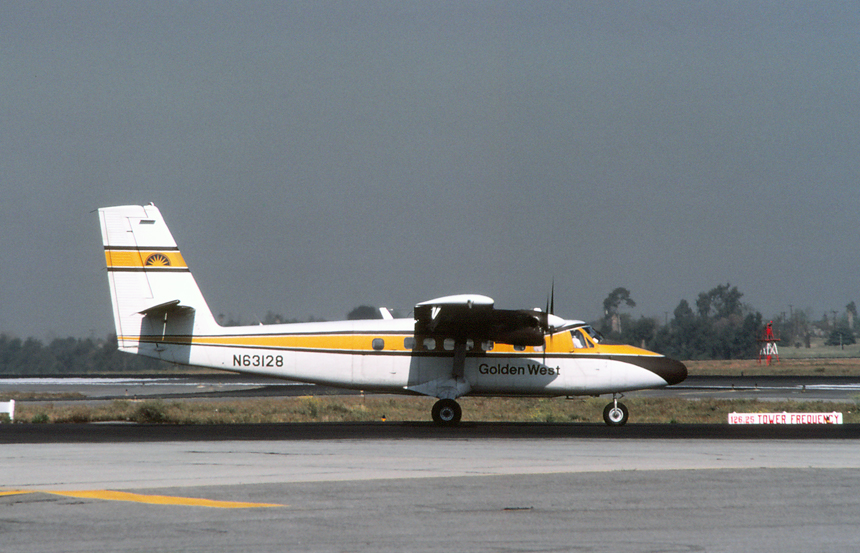
| April
1980 The workhorse of the Golden West fleet was the rugged de Havilland DHC-6 Twin Otter was capable of flying into various regional airports within the Southern California area. When Golden West was formed in 1969, the airline was flying a total of thirty-five Twin Otters. Although having been replaced by the larger Shorts 330 and newer de Havilland Canada DHC-7 Turboprops by 1980, the Twin Otter was still providing service to the smaller stations from Los Angeles such as Inyokern, Ontario, Oxnard, Palmdale, and Santa Barbara. Taxiing up to the hold-short point for Runway 24 Left and wearing the "earth-tone" colors introduced in the early 1970s is N63128, a de Havilland DHC-6-200. |
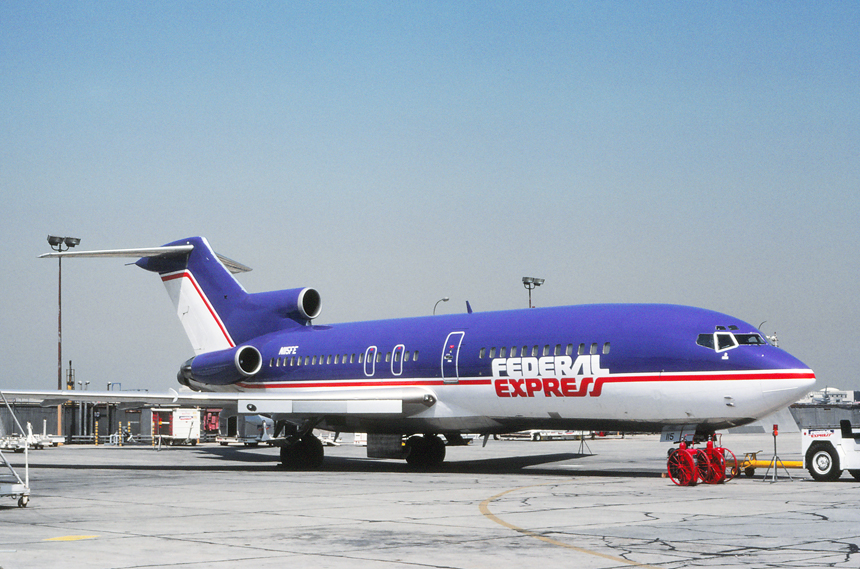
| April
1980 Federal Express continued to acquire second-hand Boeing 727s and convert them for package freighter service to expand it's domestic market and increase capacities. By 1980, sixteen Boeing 727 were in operation with the airline with an additional twenty "new" airframes being taken from Eastern Airlines. With a capacity five times more then the Dassault Falcons, the Boeing 727 were initially used on trunk routes for the carrier including cargo flights to Los Angeles, San Francisco, Boston, and New York-LaGuardia. Seen on the south cargo ramp is N115FE "Tracey," a Boeing 727-116C, originally with LAN Chile and delivered to Federal Express in July 1979. |
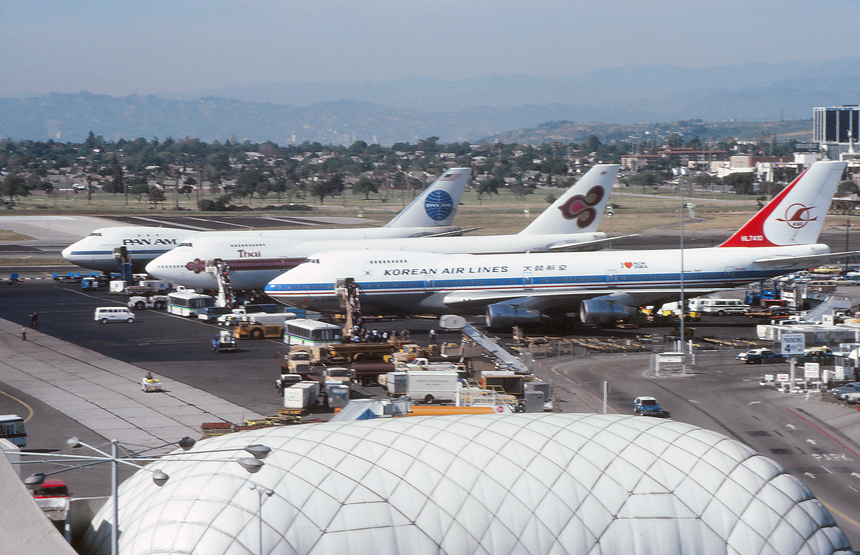
| May
1980 By 1980, Los Angeles had truly become a "global" city as evidence by the trio of Boeing 747 "Jumbo Jets" parked at the International Overflow ramp, which would later become Terminal 1. Both Korean Air Lines and Thai Airlines Boeing 747-200s are loading passengers for afternoon departures, while the Pan Am Boeing 747-100 is being "turned" for an evening flight. |
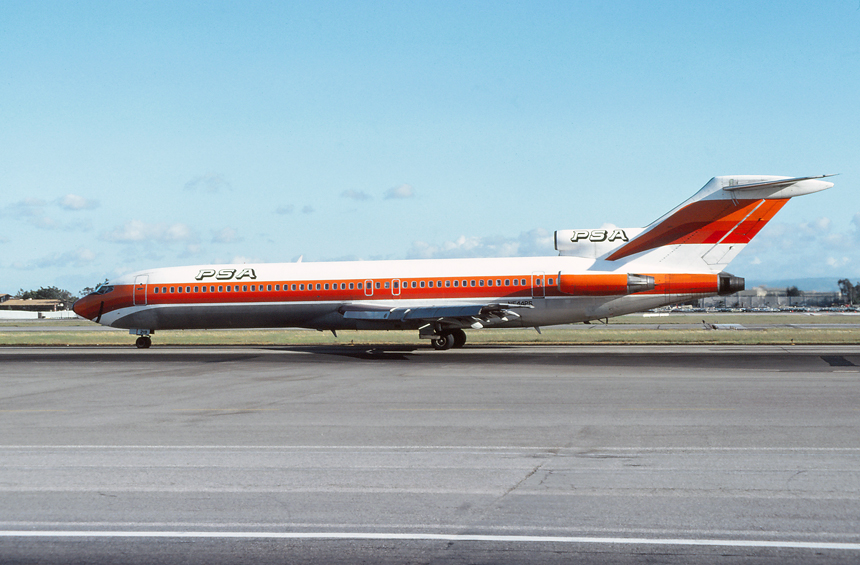
| May
1980 The Boeing 727 was the flagship of the Pacific Southwest Airlines (PSA) fleet with thirty-one aircraft being used by 1980. During this time, PSA was now serving Los Angeles with over sixty daily flights to ten cities across four states, all using the Boeing 727. Seen taxiing toward Runway 25 Right for an evening departure is N544PS, a Boeing 727-214, delivered new to PSA in September 1970. |
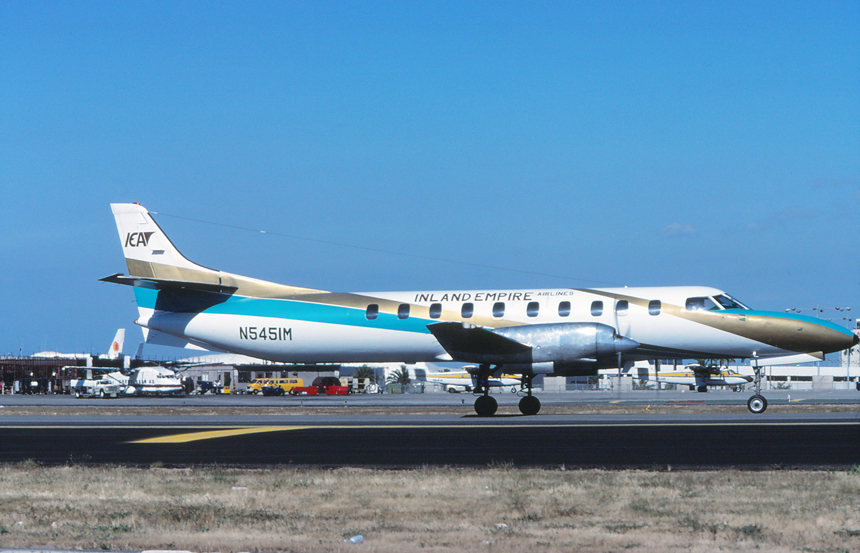
| May 1980 As a product of the new deregulation legislation, Inland Empire Airlines was formed in 1978, to start scheduled passenger flights from points in both central and southern California. Hoping to fill the void left by carriers such as Hughes Airwest, abandoning many smaller markets, Inland Empire with a fleet of four Metro turboprops provided commuter service from small cities such as Visalia and Ontario into Los Angeles. The airline eventually expanded north and provided services in the Bay Area at Both San Jose and San Francisco. Taxiing away from the commuter ramp for another regional flight is N5451M, a Swearingen SA-226TC Metro II. |

| June
1980 Braniff International was no stranger to the Boeing 747 having operated the type briefly in the early 1970s. During the late 1970s, Braniff was awarded trans-Pacific service to Hong Kong and Singapore and decided to purchase four of the ultra-long range Boeing 747SP “Special Performance” variant of the legendary aircraft. The first aircraft was delivered on October 30, 1979, in a bright orange color scheme accented by yellow stripes followed by a second a few months later. Although initially placed on the Los Angeles-Honolulu-Guam-Hong Kong route, the new 747SP was also slated for a Dallas-Bahrain “Oil Route” that never materialized. Although the SP’s served Braniff well, after the delivery of the third in May 1980, high fuel costs and an economic recession which resulted in lower trans-Pacific traffic caused the airline to cancel its Pacific routes in May 1982. The three Boeing 747SPs were eventually sold and the fourth order was cancelled. Having just been delivered weeks earlier and turning in toward the gate at Terminal 3 is N606BN, a Boeing 747SP-27, delivered new to Braniff International on May 30, 1980. |

| June 1980 Cochise Airlines was one of the first carriers to receive official "Commuter" certification by the Civil Aeronautics Board (CAB) in 1971. The airline based in Tucson, initially started as a taxi and tour group operator before establishing schedule passenger flights within its home state of Arizona. In 1977 interline agreements were signed with various airlines at both Phoenix and Tucson and Swearingen Metroliners were ordered. Convair 440s were acquired in 1978 to increase service and eventually expand flights to El Centro, San Diego, Blythe, and Los Angeles in California. With the quick expansion and competition by other regional airlines, Cochise fell into financial difficulties and ceased operations in June 1982. Parked on the commuter ramp and awaiting taxi clearance for another flight to El Centro/Imperial Airport is N23AZ "City of Yuma," a Swearingen SA-226TC Metro II. |
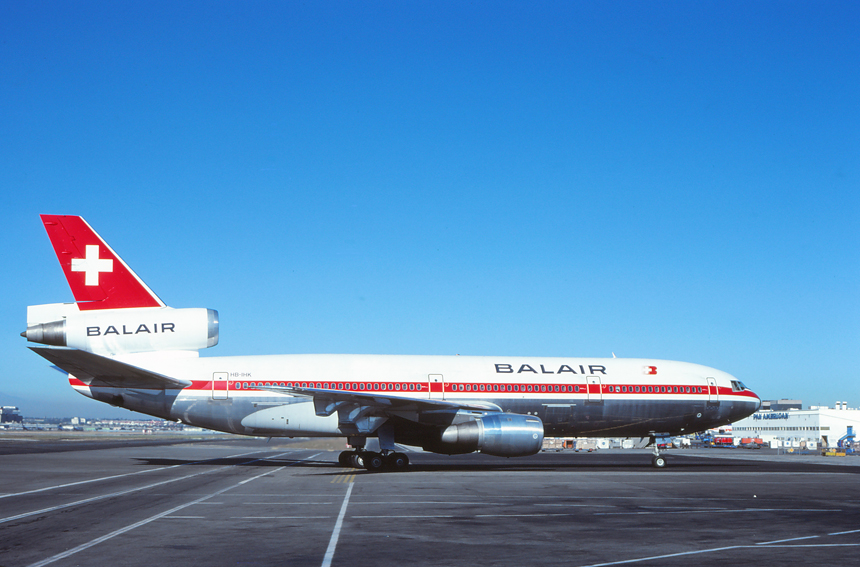
| July 1980 Balair was formed in 1953, as a flight school with passenger charter operations starting in 1957. With investment by Swissair, the Swiss government and other private interests, Balair become the largest charter airline in Switzerland. With a focus on tour groups for intra-European and intercontinental vacation packages, the airline could be seen throughout the world at holiday destinations. During the late 1970s, the airline ordered a sole Douglas DC-10 for increasingly popular tour group flights to North America. The DC-10 had the range and capacity to make non-stop flights from Switzerland to the U.S. West Coast as well as New York and Chicago. Los Angeles was a popular destination and companies DC-10 was seen frequently on charter services from both Zurich and Basel. Taxiing inbound into the Imperial Terminal complex on a bright summer day is HB-IHK, a Douglas DC-10-30, delivered new to the airline on January 31, 1979. |

| July
1980 Trans World Airlines (TWA) used the Boeing 707 as the foundation of its fleet from 1959, through the eventual retirement of the aircraft in 1983. The airline operated over one hundred-thirty various Boeing 707 variants and helped the global airline regain its standing as a reputable carrier. Los Angeles saw TWA's Boeing 707s operate a majority of services throughout the 1960s and 1970s on medium and long haul routes. Although by 1980, even through the airplane was slowly being withdrawn from service, LAX still had service to nine cities using the venerable four-engine jetliner including Chicago, Newark, Oklahoma City, St. Louis, and San Francisco. Taking the active Runway 24 Left for a morning departure is N748TW, a Boeing 707-131B, delivered new to the airline on April 30, 1962. |

| July
1980 By 1980, Delta Airlines was operating twenty-nine of the Lockheed L-1011 Tristar and became the largest operator of the type world-wide. The L-1011 was used extensively from Los Angeles on both shorter segments such as flights to San Diego and San Francisco as well as longer routes to Atlanta and Dallas-Ft. Worth. Caught over the numbers for Runway 24 Right on a pleasant summer evening is N716DA, a Lockheed L-1011-193C Tristar, delivered new to the airline in November 1974. |

| August
1980 The national airline of Costa Rica, Lineas Aereas Costarricenses S.A. or LACSA was formed in 1945 as a joint venture between the Costa Rican government and Pan American Airways. For the next thirty years the airline provided flights from its San Jose, Costa Rica base to Panama City, Panama, Grand Cayman, Miami and Mexico City, using Douglas DC-6Bs and eventually starting "jet" service with the British Aerospace BAC-1-11 twinjet. During 1980, LACSA took delivery of two new Boeing 727s and extended routes across the Caribbean and South America. Los Angeles was added to the route network in July 1980, as an extension of its popular San Jose-Mexico City service. Taxiing outbound along taxiway Uniform for takeoff is N1280E "Bri-Bri," a Boeing 727-2Q6, delivered new to the airline a month earlier on July 10, 1980. |
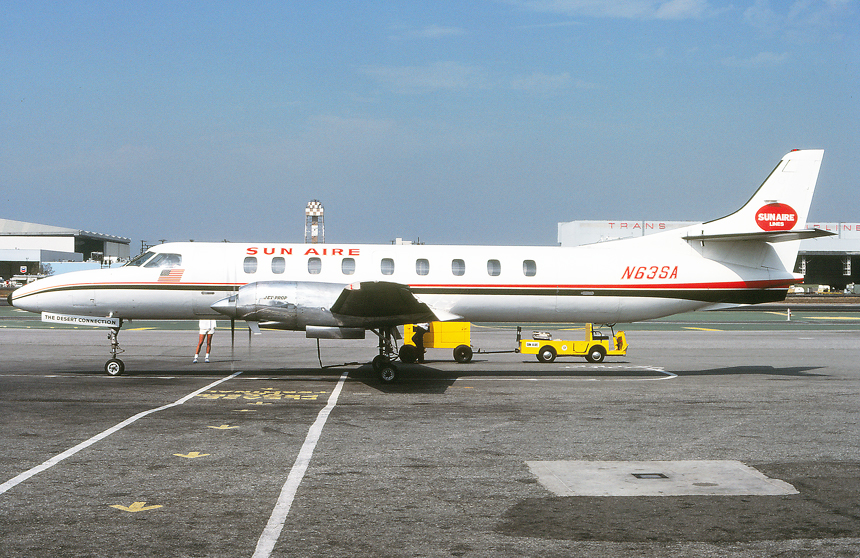
|
August 1980 Palm Springs based Sun Aire Lines started "Desert Connection" services into Los Angeles International Airport-LAX during 1977 with flights to Palm Springs. Although competing with Hughes Airwest on the route, Sun Aire was able to establish a customer base and soon started service to Imperial-El Centro and Santa Maria airports using a fleet of Swearingen Metroliners. Seen getting ready to depart the commuter terminal ramp on a morning flight is N63SA, a Swearingen SA-226TC Metro II. |
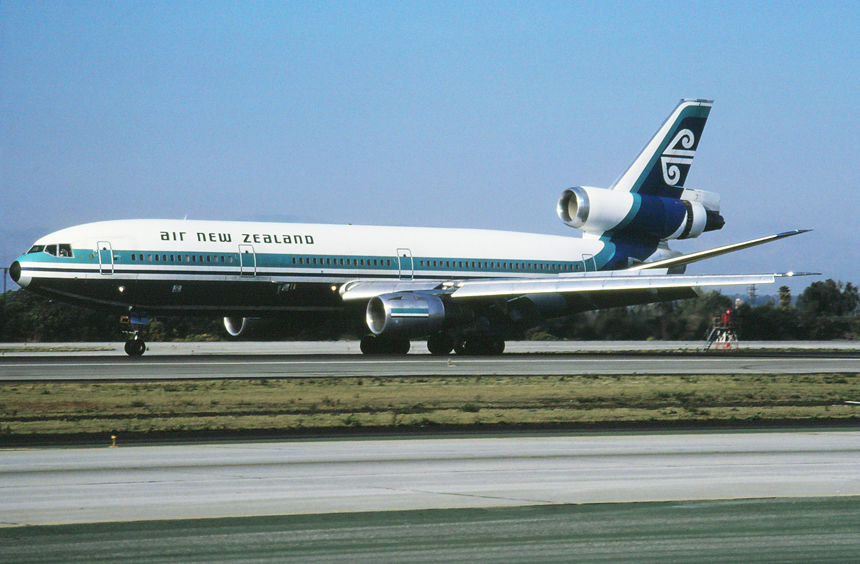
|
September 1980 The national airline of the island country of New Zealand, Air New Zealand ordered eight of the long range Douglas DC-10-30 for use on trans-Pacific, Far East and European services. The first DC-10 was delivered in January 1973 and initially placed on the popular Auckland-Sydney route. In October 1973, the DC-10 replaced the DC-8 on the Los Angeles-Papeete-Auckland route and become the aircraft of choice on the famous "Southern Cross" service throughout the 1970s. With the introduction of the larger capacity Boeing 747 in 1981, Air New Zealand started to retire the Douglas tri-jets with the last one leaving the fleet in 1982. Rolling out on Runway 24 Left after a trans-Pacific flight is ZK-NZR, a Douglas DC-10-30, delivered new to Air New Zealand on October 2, 1975. |
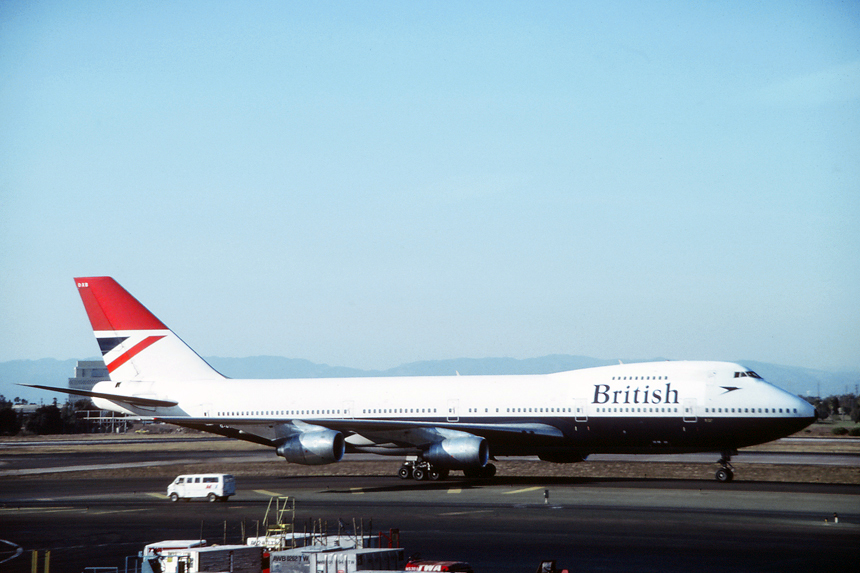
|
October 1980 During 1965, Britain's government controlled airline, British Airways was formed in April 1974, by the merger of British Overseas Airways Corporation (BOAC) and British European Airways (BEA). As part of BOAC's world-wide network, Los Angeles was added to the route map with non-stop service to London in 1961, (technical stop enroute at Montréal, Canada) using Boeing 707 aircraft. The service lasted only a few years until 1963, when flights were stopped. In 1968 service was reinstated to Los Angeles via New York City then to London. During that same year, BOAC placed an order for eleven of the new Boeing 747 Jumbo Jets with the first being delivered in April 1970. The new "Jumbos" were placed on the airlines more popular routes to North America, the Far East and Australia, including the non-stop services to Los Angeles. After the merger, British Airways continued to use the 747 on the daily Los Angeles-London flights. Having just landed and taxiing toward the International Arrivals at Terminal 2 is G-BDXB, a Boeing 747-236B, delivered new to British Airways on February 22, 1977. |

| October
1980 When Pan Am purchased National Airlines in 1980, the legendary carrier acquired much coveted domestic US routes, that had traditionally been awarded to other airlines prior to airline deregulation. With the purchase, Pan Am took over the sixteen Douglas DC-10 airplanes that were being operated or on order by National. Although, Pan Am was already operating the Lockheed L-1011, the Douglas DC-10s provided the needed capacity on the new routes assumed, including on services from Los Angeles to Miami and Houston. Wearing the familiar colors of its new owner and having just been pushed back from Terminal 2 is N62NA, a Douglas DC-10-10, delivered new to National Airlines on December 21, 1971. |
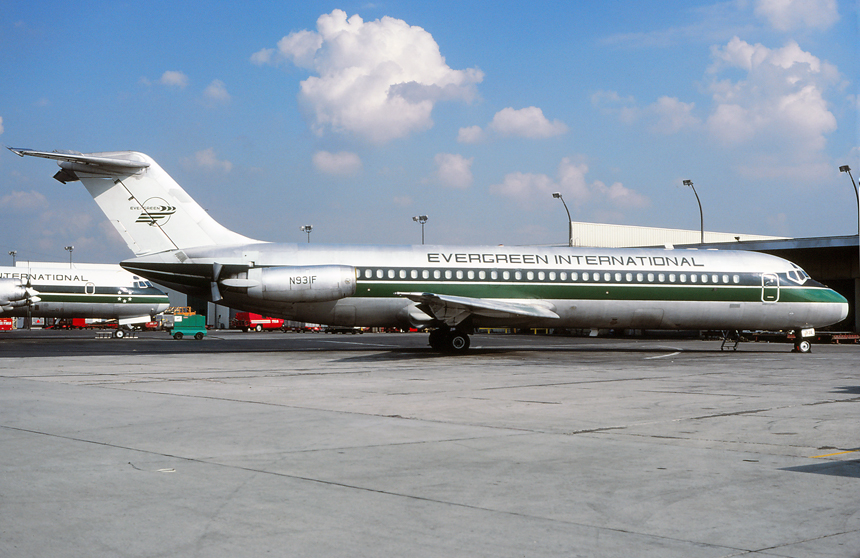
| December
1980 Evergreen International Airlines started operations in 1960 as a helicopter charter operator based in McMinnville, Oregon. After deregulation in 1978, Evergreen purchased the Lockheed L-188 Electra to start charter operations and by 1980 had purchased four Douglas DC-9 Freighters for contract charter cargo work from New York to other cities including Los Angeles. Parked at the cargo ramp in a bare metal color scheme is N931F, a Douglas DC-9-33RC, purchased by Evergreen in October 1976. Unfortunately this aircraft was lost in an accident at Carswell Air Force base, Texas on March 18, 1989. |
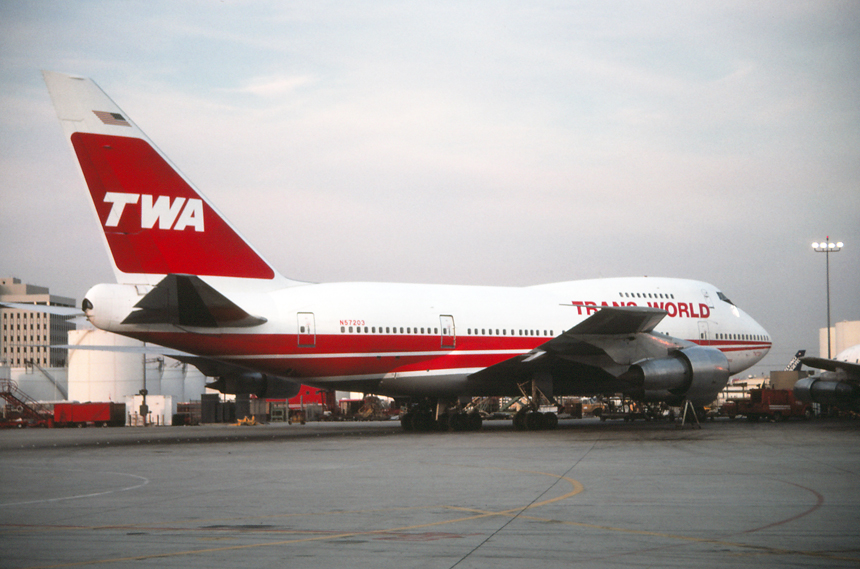
| December
1980 Trans World Airlines (TWA) had a close relationship with Boeing, especially with the manufactures successful Boeing 747 Jumbo Jet. When Boeing introduced its "Special Performance" version of the legendry aircraft, TWA wasn't initially interested in a purchase. With the possibility of routes to the Middle East, TWA saw the super-long distance 747 as a solution to non-stop flights from Eastern Seaboard cities to the Middle East. TWA ordered three aircraft in 1978, however the routes to the Middle East never materialized. The 747SP was used however on some trans-Atlantic and trans-continental routes such as Los Angeles-New York before operating economics had TWA retire the plane in 1986. Parked at the TWA maintenance ramp on the west side of the airport is N57203, a Boeing 747-SP31, delivered new to TWA on May 8, 1980. |
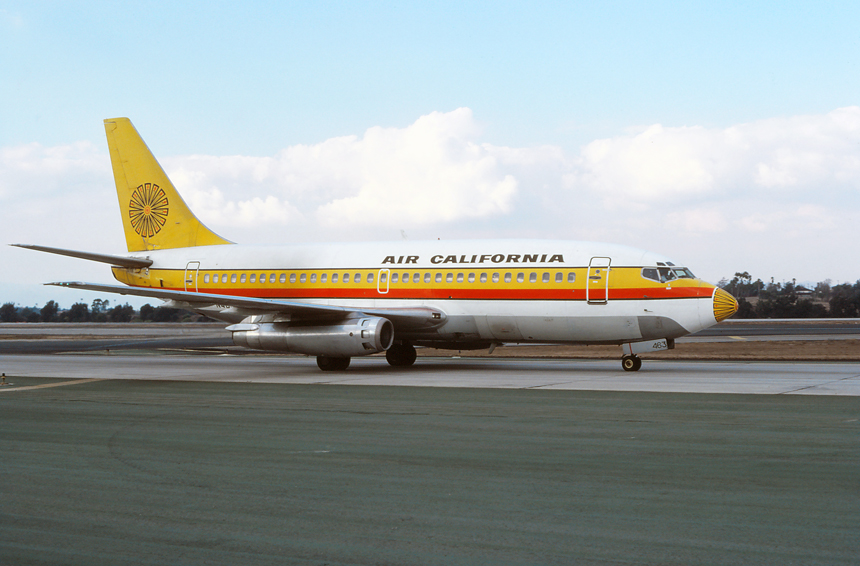
|
December 1980 Los Angeles was the last major airport in Southern California that Orange County based Air California had yet to add to its route network. Los Angeles was much sought after however many regional airlines had established service and passenger bases at the airport years prior such as Air California's main intra-state competitor, Pacific Southwest Airlines (PSA). To establish a foothold, Air California accepted route awards to secondary cities, Fresno and Monterey for which the main-line carriers had departed. These new flights started in July 1980, and allowed entry into the lucrative LAX airline "fraternity." Taxiing toward Terminal 3 after having landed is N463GB, a Boeing 737-293, originally destined for Pacific Airlines and not taken up then bought GATX-Boothe Aircraft and leased out to Air California on July 10, 1968. |

| December
1980 In an effort to further it's reach into the Americas, Braniff purchased Pan American-Grace Airways (PANAGRA) in 1967. Along with the routes into South America, Braniff acquired PANAGRA’s fleet of seven Douglas DC-8 aircraft, which would be a new type operated by the airline. Braniff soon realized that the DC-8 had the necessary performance and range to operate into some of Latin Americans more demanding airports and kept the planes flying the predominantly South American routes. With the purchase of PANAGRA, Braniff saw new cities being added such as San Francisco and Los Angeles, and the non-stop Los Angeles-Lima and Los Angeles-Panama City route. Eventually a Los Angeles-Santiago route was started using the venerable DC-8 on the non-stop, 5,564-mile sector. The Douglas DC-8 remained in the Braniff fleet providing a pivotal role in the South American flights until the airline's bankruptcy in May 1982. Awaiting takeoff clearance and holding short of Runway 24 Left and wearing the chocolate brown “Ultra” colors introduced in 1978, is N1809E, a Douglas DC-8-62, delivered new to the airline in November 1969. |
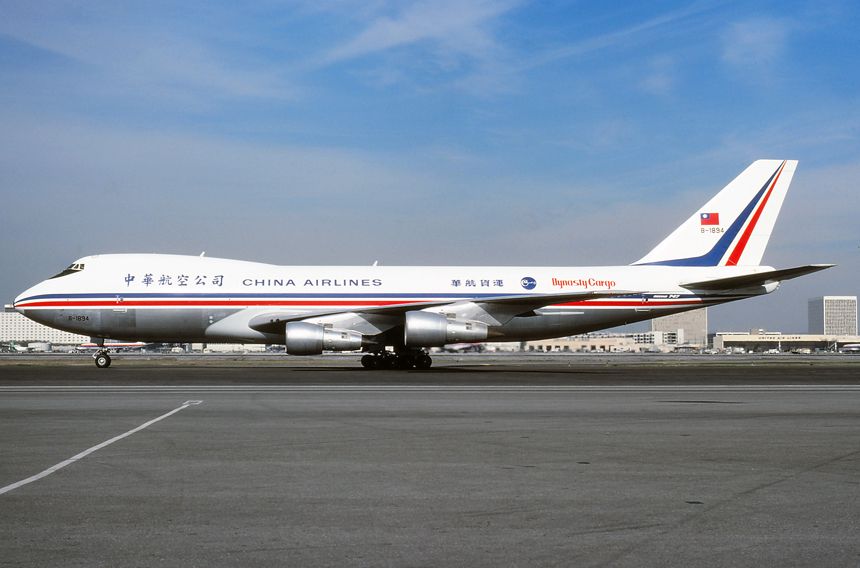
|
January 1981 Taipei, Taiwan based China Airlines realized with the increase in cheap exports from Taiwan during the early 1970s the opportunity to establish a cargo only air-route. In 1974, the airline placed a Boeing 707 freighter on service between Los Angeles and Taiwan via Anchorage. With continued growth of the "Dynasty Cargo" division, China Airlines received its first Boeing 747 Freighter in 1980, specifically manufactured for carrying approximately 256,000 pounds (128 tons) of cargo. Awaiting clearance for taxi after having been pushed back from the south cargo complex is B-1894, a Boeing 747-209F (SCD), delivered new to China Airlines in July 1980. Subsequently this aircraft was written-off in an takeoff accident while flying for Kalitta Air at Brussels, Belgium on May 25, 2008. |

|
January 1981 Having established service into Los Angeles in 1975, Vancouver, Canada based CP Air continued its single city service between LAX and Vancouver using mainly the Boeing 727 and Boeing 737 on the route. Occasionally the airline's Douglas DC-8 was substituted on the route, such as this example, CF-CPM "Empress of Lisbon," a Douglas DC-8-53, having just landed and taxiing toward the terminal on a bright winter day. |

|
January 1981 Although once the backbone of the Golden West fleet, the de Havilland DHC-6 Twin Otter had slowly been replaced with the larger Shorts SH-330 and newer de Havilland DHC-7 "Dash 7" aircraft. The Twin Otter still had a role in serving the smaller destinations on the airline's route map such as Edwards, Palmdale, Oxnard, and Ontario from Los Angeles and in 1981, the airline was still flying eleven examples of the type. Seen taxiing along Taxiway Foxtrot is N66180, a de Havilland DHC-6-200. |
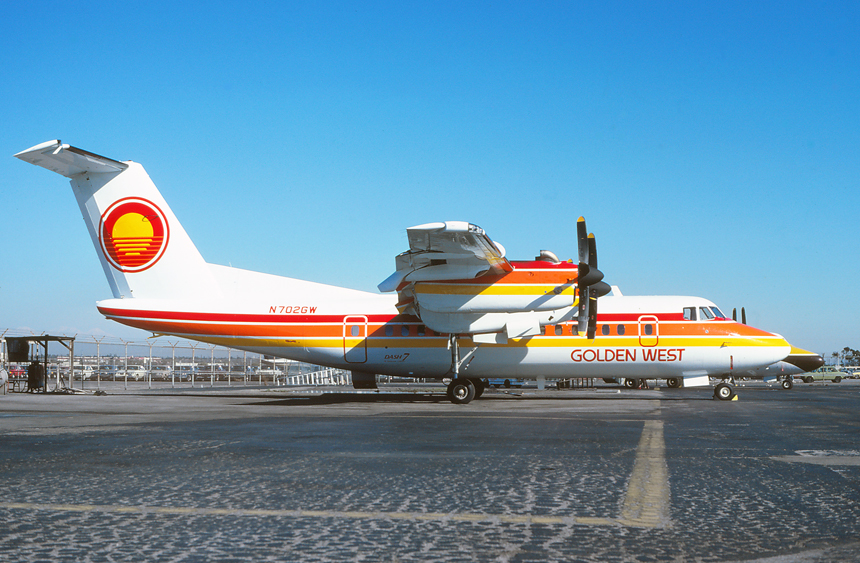
| February 1981
Golden West Airlines, seeing growth in its regional market due to deregulation and the plan of longer routes ordered five of the new de Havilland Canada DHC-7, four-engined turbo-prop. With the capability to operate in Short-Takeoff-Or-Landing (STOL) configuration, the new plane was seen as a solution for local airports in the Southern California region. The first plane was delivered in March 1980, with early services seeing the plane used on the more popular Los Angeles-Santa Barbara, Los Angeles-Orange County, and Los Angeles-San Diego routes. Parked at the Golden West maintenance ramp on the south side of the airport is N702GW, a de Havilland DHC-7-102 "Dash 7," wearing the new "sunset" colors introduced in October 1980. |
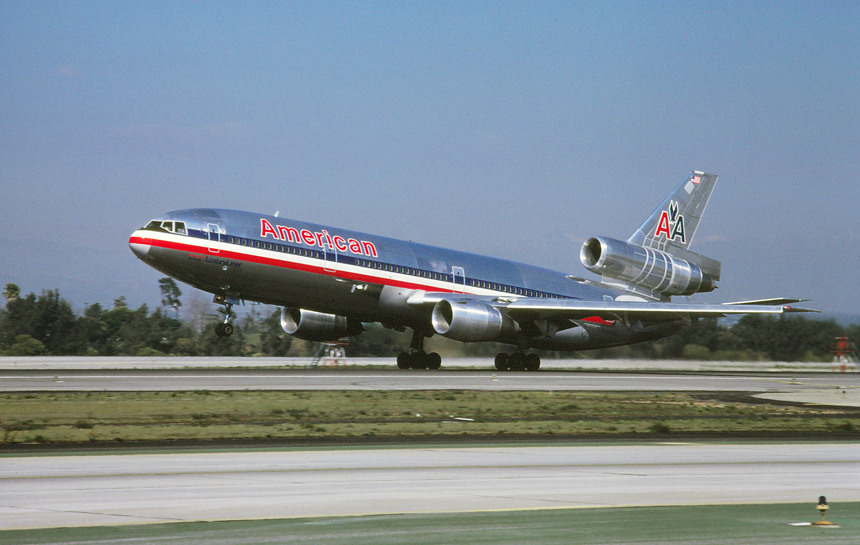
|
March 1981 After the grounding of the Douglas DC-10 in June 1979, after the tragic crash of American Airlines Flight 191 in Chicago, American slowly reintroduce the Douglas Tri-Jet after FAA mandated changes and recommendations. A more subtle change was the removal of the "DC-10" label preceding the "LuxuryLiner" moniker just under the forward main passenger door, and replacing it with "American Airlines." By 1981, American was using the Douglas DC-10 again on higher capacity flights from Los Angeles to Chicago, Dallas, Honolulu, San Diego, and Washington-Dulles. Seen rotating for takeoff from Runway 24 Left is N134AA, a Douglas DC-10-10, delivered new to the airline a year earlier on May 23, 1980. |
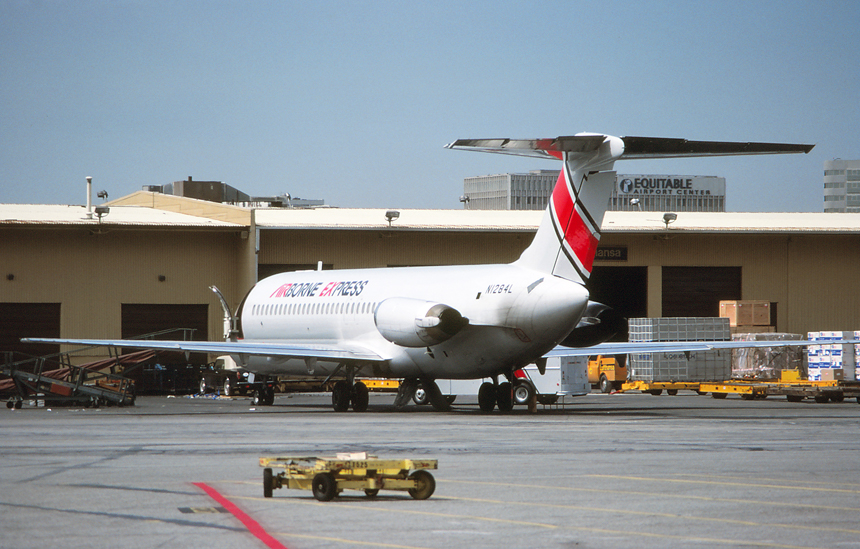
|
March 1981 Express package airline Airborne Express started operations in 1946, as Airborne Flower Traffic Association of California flying flowers from Hawaii to the US Mainland. This niche market lasted for over two decades until 1968, when the airline incorporated the use of newly designed “C” containers which would use the existing doorways to load cargo and allowed better aircraft options. After some small acquisitions, the company moved to Seattle, Washington and saw an opportunity for growth after the air cargo deregulation of 1978. During April 1980, the airline became known as Airborne Express and initially acquired a small fleet of NAMC YS-11 turboprops, the French built Caravelle and four Douglas DC-9s operating from a Wilmington, Ohio base. Parked at the north cargo ramp and awaiting its freight for the evening is N1284L, a Douglas DC-9-32. |
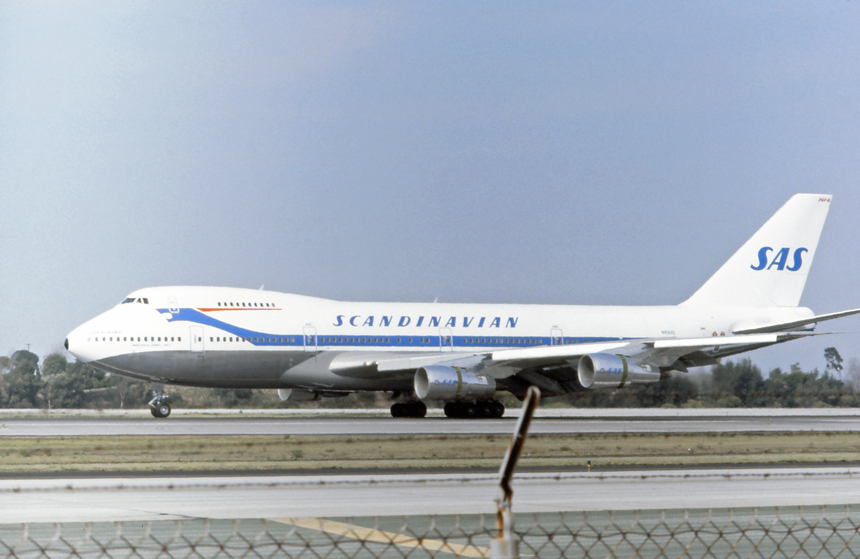
|
March 1981 In 1971, SAS Scandinavian Airlines placed into service the long-range Boeing 747 for international services. Los Angeles continued to be served by SAS with flights to Copenhagen via Seattle using the DC-10 and Boeing 747 which was introduced on the route in 1979. Eventually the Boeing 747 was able to provide non-stop service to Copenhagen, Denmark a few years later. Seen in reverse thrust and rolling out on Runway 24 Left is N4501Q "Dan Viking," a Boeing 747-283B, delivered new to the airline on February 17, 1981. |
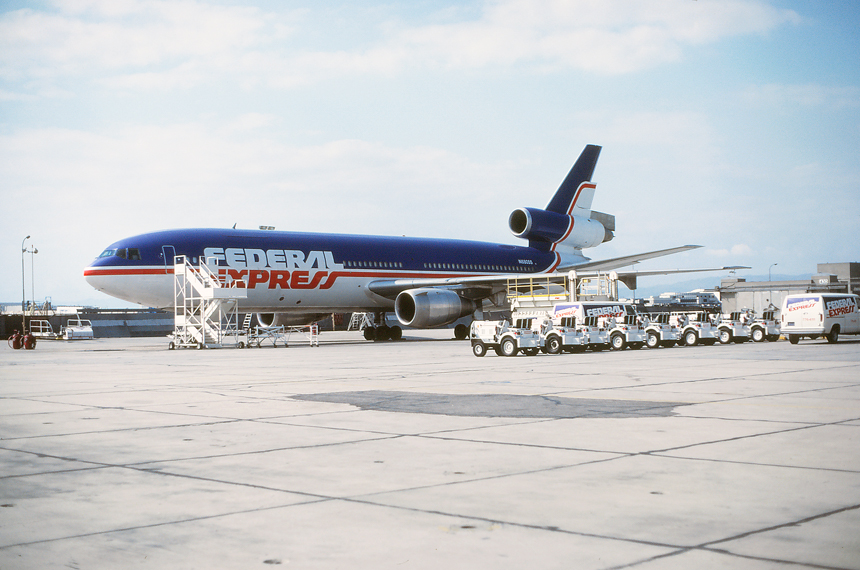
|
March 1981 In the years just after the air cargo deregulation legislation of 1977, cargo carrier, Federal Express saw its overnight package service skyrocket. Moving to larger capacity aircraft such as the Boeing 727 and Boeing 737 in 1978, Federal Express took the bold step of converting three ex-Continental Airlines Douglas DC-10 for its biggest markets in 1980. Los Angeles was soon hosting the purple and crimson colored DC-10s with a capacity of 130,000 pounds on daily night flights to the carriers Memphis, Tennessee cargo hub. Parked at the cargo ramp and awaiting its evening deliveries is N60855, a Douglas DC-10-10CF purchased by Federal Express in March 1980. This aircraft was destroyed by a fire after an emergency landing in Newburgh, New York with all crew members evacuated safely. |
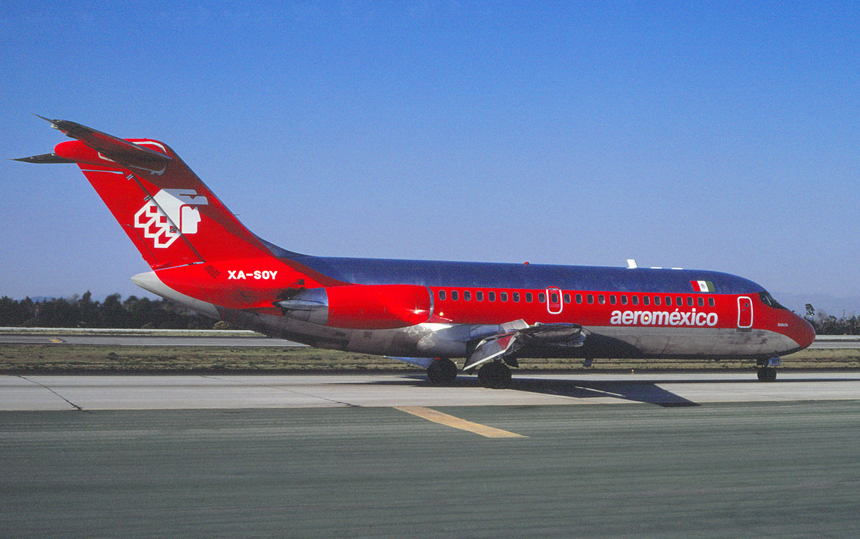
|
March 1981 By 1981, Aeromexico was flying a mixed fleet of nineteen Douglas DC-9s between the smaller -10 and the larger capacity -30. The Douglas twin-jet was used extensively on domestic Mexico services as well as cross-border international flights. During 1981, flights from LAX to both Guadalajara and Monterrey were using the DC-9s on the daily flights. Seen taxiing toward international arrivals at Terminal 2 after having landed is XA-SOY "Sinaloa," a Douglas DC-19-15, wearing the airlines new colors introduced a few months earlier. |

|
April 1981 Taipei, Taiwan based China Airlines was an early operator of the ultra long-range Boeing 747SP "Special Performance" aircraft with an order of four examples. Due to political issues, Taiwan had ended diplomatic ties with Japan in 1972, and this caused the traditional stop-overs in Tokyo on trans-Pacific services to be stopped. The 747SP would allow non-stop flights from Taiwan to the West Coast of the U.S. effectively bypassing the Japan stop and resulting in direct routing. Services to both Los Angeles and San Francisco were started from Taipei after the airline received its first "SP" in 1977. Seen taxiing toward Runway 24 Left for an evening departure is B-1880, a Boeing 747SP-09, delivered new to the airline in April 1980. |
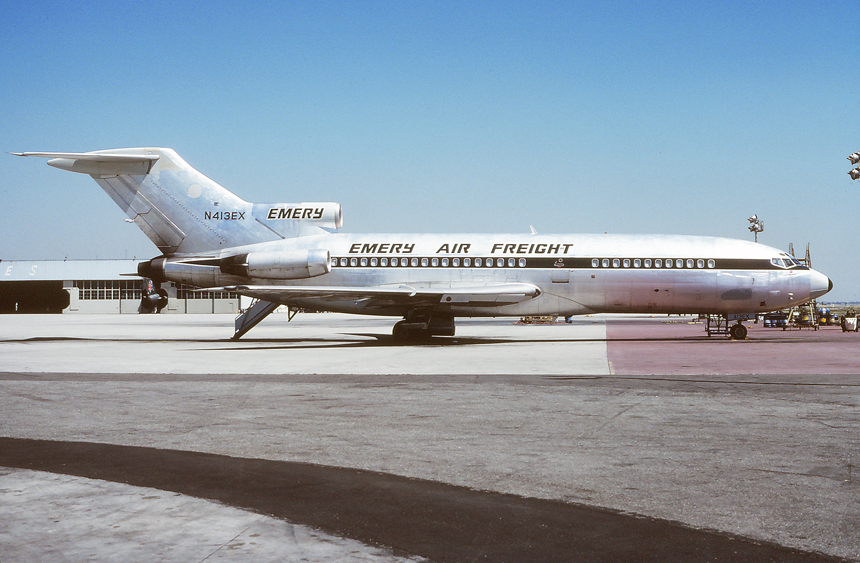
|
April 1981 In an effort to continue to compete in the post air cargo deregulation market, especially with Federal Express, Emery Air Freight purchased twenty-four Boeing 727s on the secondary market, and leased an additional forty aircraft. Using the centralized hub concept, Emery established a "super" cargo hub in Dayton, Ohio for which all packages were transported to, sorted, and then re-delivered to their ultimate destination. Seen parked on the American Airlines maintenance ramp is N413EX, a Boeing 727-51C, originally with Northwest Orient Airlines and leased to Emery in February 1981. |
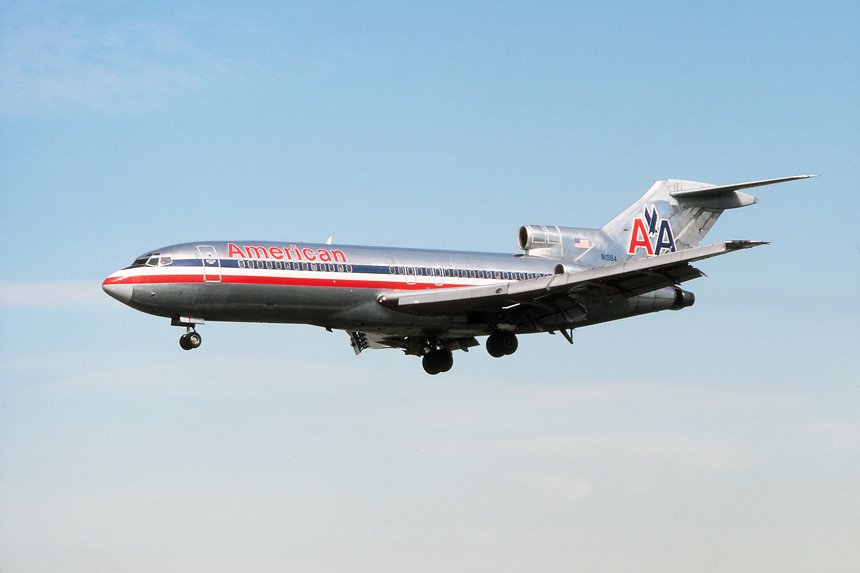
|
April 1981 American Airlines took delivery of its first 727 airplane in 1964 as a eventual replacement for the Lockheed Electra as well as to provide "jet" service to airports too small to accommodate the Boeing 720/707 fleet. With a capacity of 118-passenegrs in a two class configuration the -100 series were seen operating from Los Angeles on short and medium range service to destinations such as Dallas-Ft. Worth, Memphis, Oklahoma City, and San Francisco. Seen on final approach for landing is N1984, a Boeing 727-23, delivered new to the airline on August 28, 1964. |

|
May 1981 Air Canada ordered the Boeing 747 "Jumbo Jet" for "heavy" transcontinental routes as well as trans-Atlantic services. The first plane was delivered in February 1971 and a few months later flew the inaugural Toronto-Vancouver service on April 25, 1971. During 1981, Air Canada started using the Boeing 747 on trans-border services from Toronto to Miami, Tampa, and Los Angeles, especially during the busy winter season. Seen rolling for takeoff on Runway 24 Left during an overcast morning is C-GAGB, a Boeing 747-233B (M) a mixed cargo-passenger configuration delivered new to the airline in January 1979. |
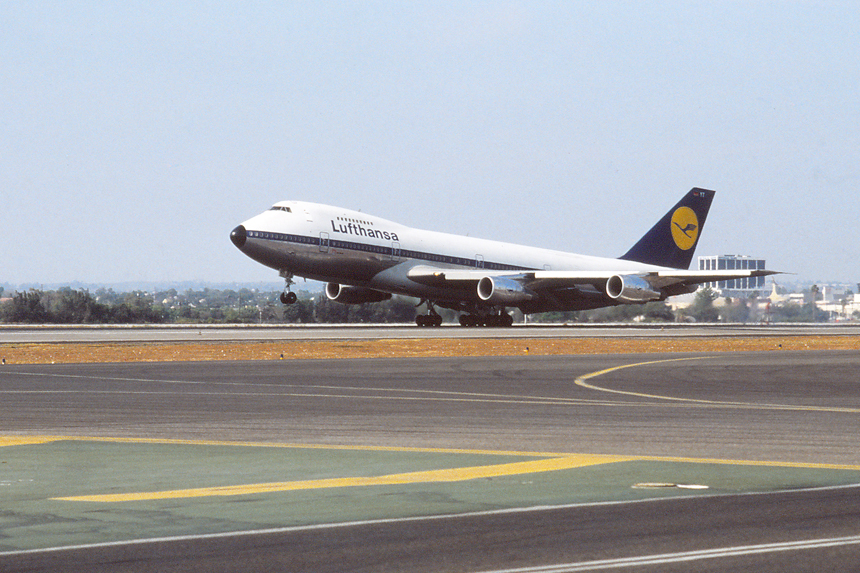
|
May 1981 On April 3, 1977, Lufthansa inaugurated non-stop service from Frankfurt to LAX using the Boeing 747 SL fitted with additional fuel tanks used for the 5,800 mile long flight. Having just touched down on Runway 24 Right after a trans-Atlantic flight is D-ABYT "Hamburg," a Boeing 747-230B (M), delivered to the airline in November 1980. |
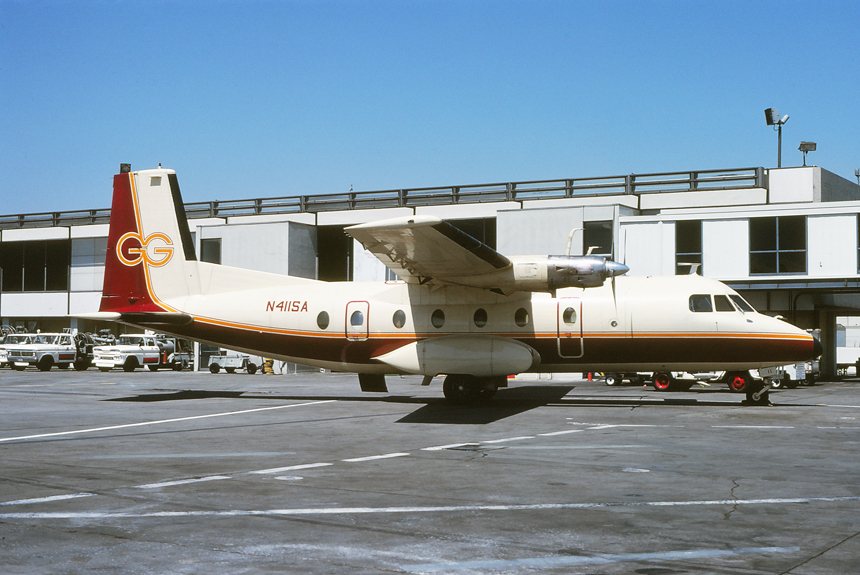
|
June 1981 San Luis Obispo based Swift Aire was founded in 1969, to reintroduce air service to the small Central California city. Both Los Angeles and San Francisco were crucial destinations in the airlines network and used a variety of non-traditional aircraft such as the de Havilland Heron and Nord 262 turboprops. Multiple daily flights connected Los Angeles to San Luis Obispo, Santa Maria, and Bakersfield before the airline was purchased by the new Golden Gate Airlines in 1981. Seen wearing it's new owners colors scheme on the ramp at Gate 84 is N411SA, a Nord 262A-12, purchased by Swift Aire in October 1979 |
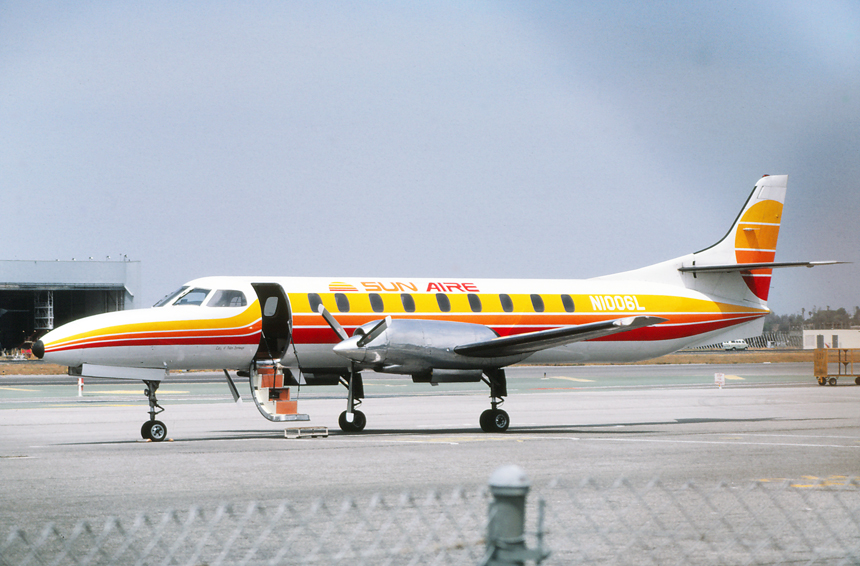
|
June 1981 Palm Springs based commuter Sun Aire had established itself as a reliable commuter airline providing flights to the eastern California desert communities, and introduced a striking new colors scheme in early 1981. Services to Los Angles were expanded adding flights to both Palm Springs and Burbank by June 1981. Parked at the commuter terminal ramp and awaiting another load of passengers is N1006L "City of Palm Springs," a Swearingen SA-226TC Metro II. |
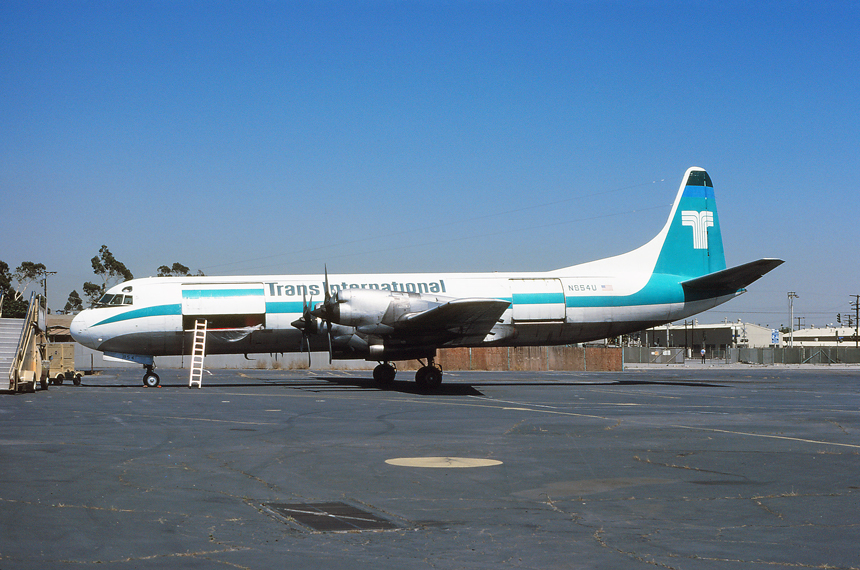
|
June 1981 With roots starting in Los Angeles in 1947 as Los Angeles Air Service which was a small charter operator flying Douglas DC-3s to Las Vegas, Nevada. Having been purchased by Kirk Kerkorian, the charter airline expanded adding additional aircraft, and becoming the first charter airline to introduce "jet" service in 1962, when a Douglas DC-8 was delivered. The airline was renamed Trans International Airlines in 1960, to reflect its growing global market with both passenger and cargo charters. Cargo and freight charters made up a significant portion of the business and a fleet of Electra "Freighters" were used as well as convertible passenger aircraft in the inventory. Parked on the cargo ramp during a cargo charter flight is N854U, a Lockheed L-188-C "Electra," originally delivered to KLM Royal Dutch Airlines in December 1959. |
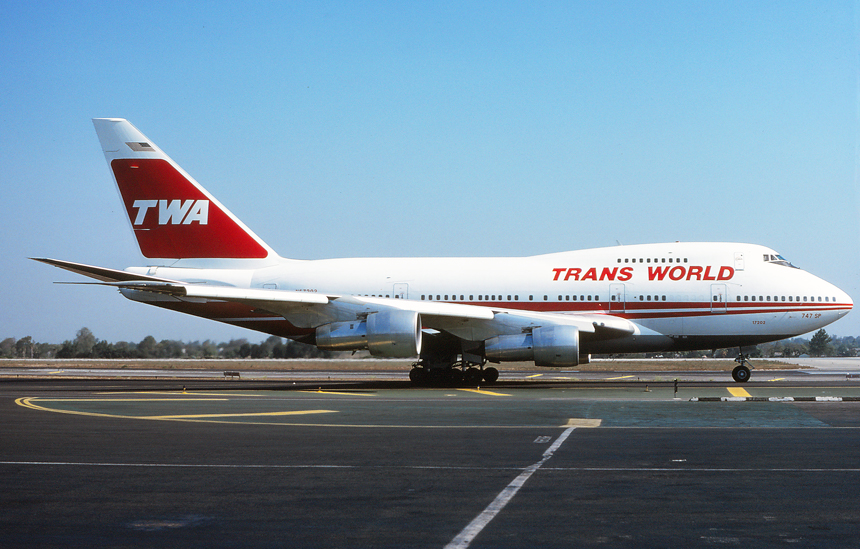
|
June 1981 Trans World Airlines (TWA) fleet of three Boeing 747SPs continued to be used on various trans-Atlantic European routes as well as transcontinental flights. By 1981, the airline was using both the Boeing 747-200 and 747SP between New York-Kennedy and Los Angeles as well as an occasional substitute on the non-stop Los Angeles-London Heathrow service. Seen taxiing toward Runway 24 Left for a morning departure is N57202, a Boeing 747SP-31, delivered new to the airline in March 1980. |
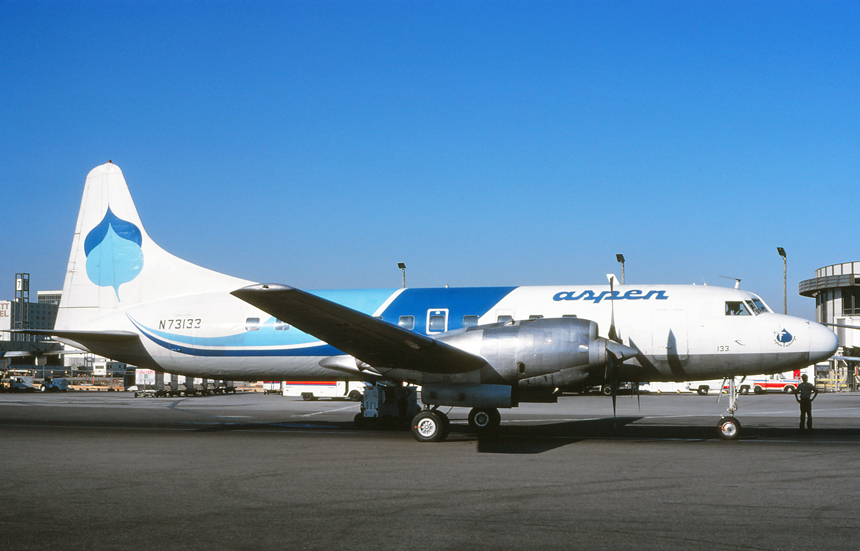
|
June 1981 Aspen, Colorado based Aspen Airways had established itself as a reliable carrier connecting Aspen and other Colorado locations with Denver. Using a fleet of turbine conversion Convair CV-580s the planes became known as the "Mountain Master" for their reliable and safe service. Having "tamed" the rugged Rocky Mountains, Aspen looked west to start service to the mountain resort city of Lake Tahoe located in the Sierra Nevada Mountains. Flights started in 1979 from San Jose, Burbank, and San Francisco to Lake Tahoe with Los Angeles service starting a year later in 1980. Seen being prepared for engine start at Terminal 8 is N73133, a Convair CV-580. |

|
July 1981 Pacific Southwest Airlines PSA had made the decision to upgrade its fleet and looked to McDonnell Douglas's new DC-9 series 80, also known as the MD-80 for its regional flight needs. With more fuel efficient operations, and much need Stage II noise signature, PSA became the first U.S. airline to order the MD-80. With a capacity of 156-passengers, the first MD-80 was delivered on November 14, 1980 and soon placed into revenue service. Seen being pushed back from Terminal 7 for a morning fight is N925PS, a McDonnell Douglas MD-81, the second aircraft being delivered in March 1981. |
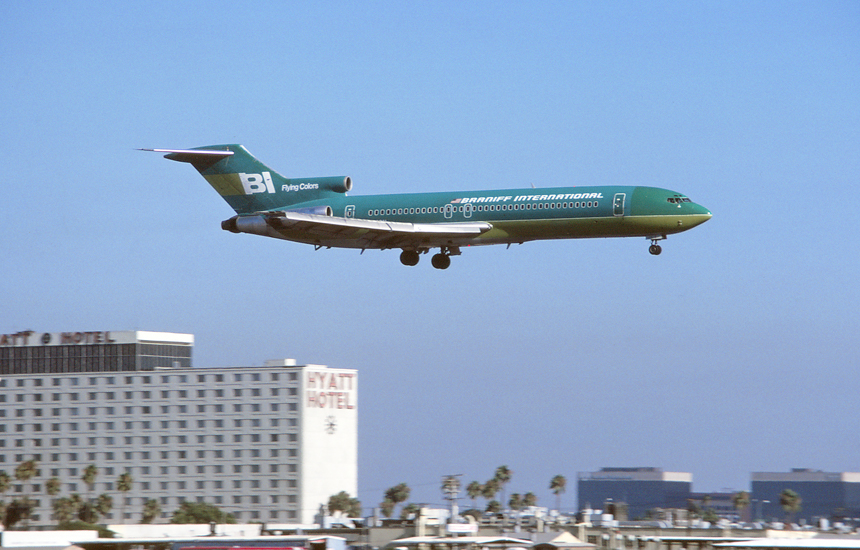
|
July 1981 Braniff International Airways continued to serve Los Angeles with both international and domestic flights. The airlines Boeing 727s were used on the four daily flights between Los Angeles and Dallas-Ft. Worth promoting Braniff's characteristic flair. Seen on short final to Runway 24 Right on a clear summer evening is N438BN, a Boeing 727-227, still wearing the two-tone green "Flying Colors." |

|
August 1981 With the increase in air cargo, especially with electronic and consumer goods, Japan Airlines (JAL) Cargo ordered the Boeing 747 Freighter specific version in the early 1970s to extend its capacity and global reach. With the ability to carry approximately 240,000 pounds of freight, JAL's new 747F was delivered on September 17, 1974. The Jumbo Freighters were soon placed on routes such as Los Angeles-Anchorage-Tokyo and became important in the international trans-Pacific cargo market. Seen in flare for landing on Runway 24 Right is JA8123, a Boeing 747-246F, and the first example to be delivered to the airline. |
Los Angeles-LAX 1980s: Page 2
Back to: The Airports